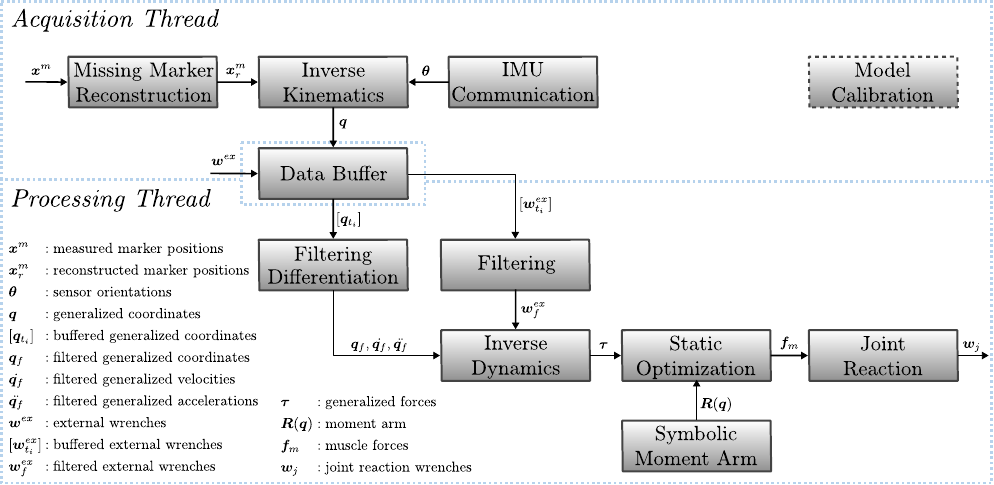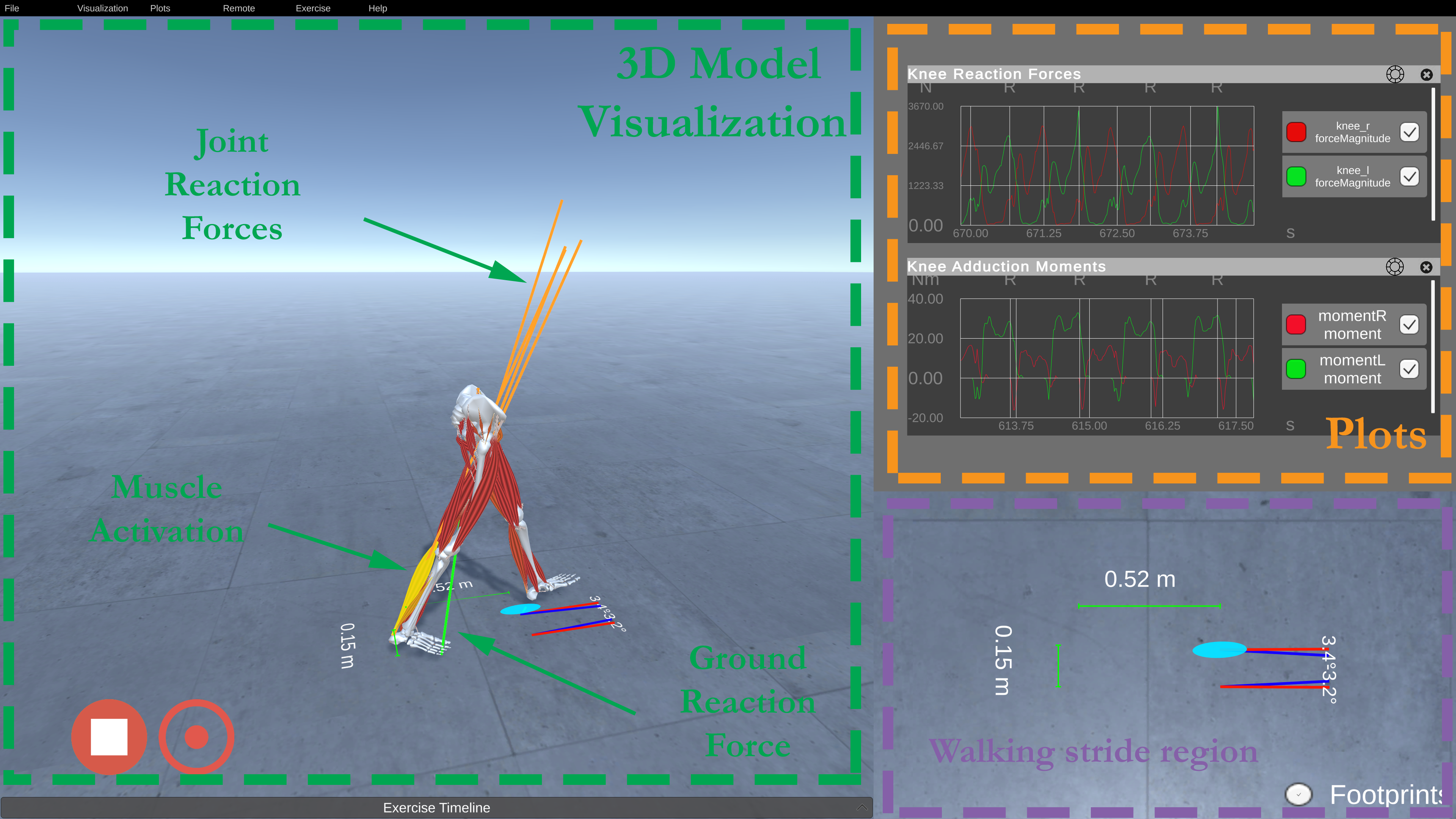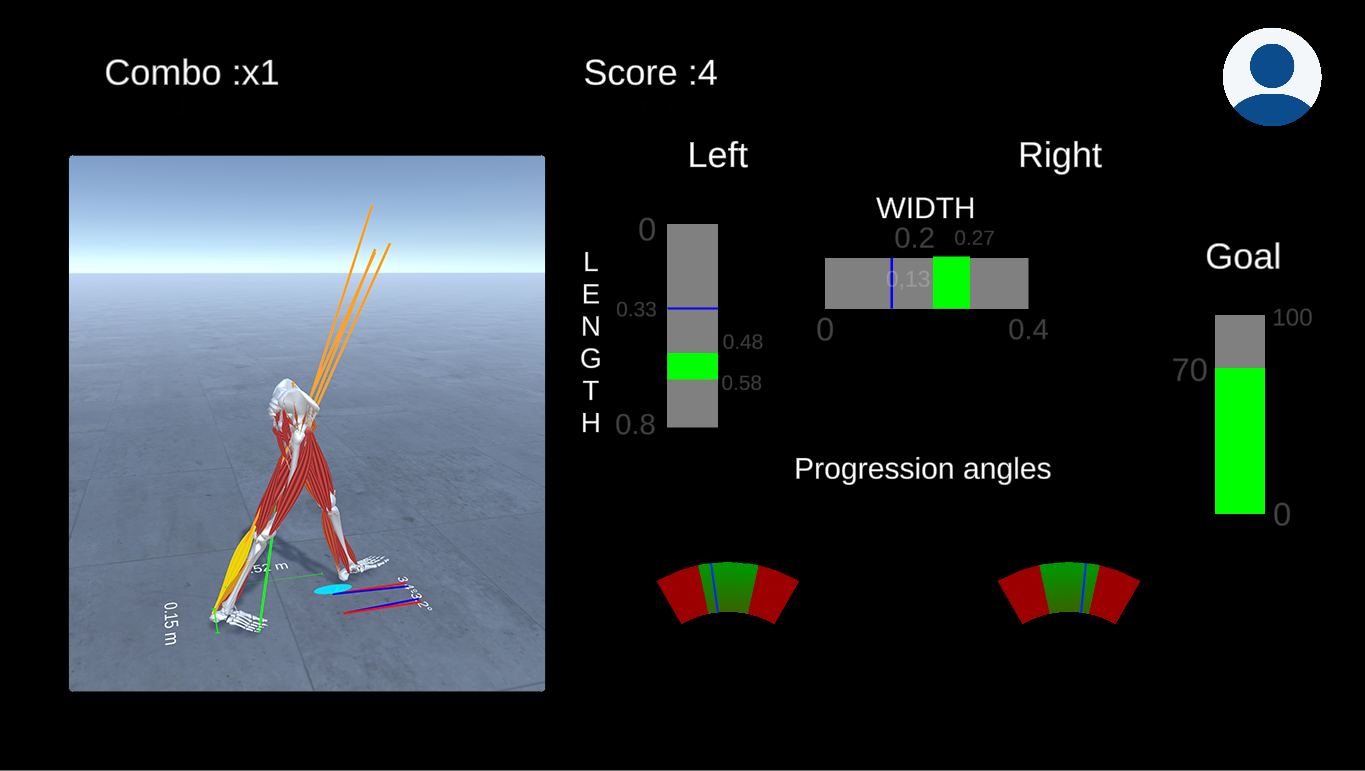Real-Time Musculoskeletal Kinematics and Dynamics Analysis Using Marker- and IMU-Based Solutions in Rehabilitation
This project aims to explore the possibility of estimating a multitude of kinematic and dynamic quantities using subject-specific musculoskeletal models in real-time. The framework was designed to operate with marker-based and inertial measurement units enabling extensions far beyond dedicated motion capture laboratories. An overview of how different modules can be linked-to calculate the joint reaction loads is presented below:
The basic operations presented in the above figure were re-implemented in a manner that enables us to call them iteratively so that information can be processed frame-by-frame. Emphasis was given that each algorithm is implemented in a simple manner. Tests were performed to ensure that online and offline results agree. We have used this pipeline to provide real-time biofeedback during gait retraining to reduce the loading of the knee:
Relative projects:
The project is organized into sub-modules. Each sub-module contains the code,
tests, and applications. Experimental algorithms (need further improvement) are
placed into the experimental folder within a module. In the test files, we
perform unit tests of each sub-component. There you can find more information on
how to use the different tools developed. For example, if you are interested in
performing inverse kinematics with IMU, you can check
/OpenSimRT/IMU/tests/TestLowerLimbIKFromFile.cpp. The organization is as
follows:
OpenSimRT/Common: a module containing common utilities such as circular buffer, dynamic library loader, exceptions, serialization, real-time filters, visualization, sensor synchronization manager, and other useful functions.OpenSimRT/IMU: a data synchronization interface NGIMU sensors, unit tests, and applications that demonstrate how to stream data and perform inverse kinematics.OpenSim/RealTime: contains the developed algorithms for performing real-time calculations. That includes inverse kinematics, inverse dynamics, muscle optimization, joint reaction analysis, and ground reaction forces prediction. You can find thetestsfolder very useful to understand how one can use individual modules. In theapplicationsyou will find an example that links multiple modules together.OpenSim/Vicon': an interface with Vicon data streamer.
The data folder contains OpenSim models (upper and lower limb) and files used
to test the developed algorithm. It also contains a setup.ini file with the
settings of the algorithms during testing. Each model (e.g., gait1992) is
organized into sub-folders with specific name conventions to automate migration
to different models. For example, experimental data are placed into the
experimental_data folder. Results from offline OpenSim analyses are placed
into scale, inverse_kinematics, inverse_dynamics,
residual_reduction_algorithm, static_optimziation,
computed_muscle_control. The real_time folder contains results from the
tests of different sub-modules. The scripts sub-folder contains automatic
Python scripts that compare real-time and offline results and generate files
into the corresponding folders. Finally, real_time/moment_arm contains Python
auto-generated C++ code for calculating the moment arm matrix (pre-computed
symbolic representation) that is linked on runtime depending on the model being
used.
This project depends on several libraries:
- opensim-core and we have tested with branch.
- If you plan to use the
Viconmodule please use ViconDataStreamSDK_1.7.1. - If you plan to use the
IMUmodule that uses NGIMU x-io Technologies Limited please build the oscpack.
For more information on how to build and set up these dependencies, please look
at the continuous integration script (.github/workflows/) and the
dependencies folder. To run the tests and examples that use files as inputs
instead of streams, you will only need opensim-core.
This work was supported by the EC Horizon 2020 project OACTIVE: Advanced personalized, multi-scale computer models preventing osteoarthritis, Grant Agreement No. 777159 (OActive). This project was developed in the Visualization and Virtual Reality Group, University of Patras, Greece.
If you find this useful you can acknowledge it as follows:
@Article{s21051804,
AUTHOR = {Stanev, Dimitar and Filip, Konstantinos and Bitzas, Dimitrios and Zouras, Sokratis and Giarmatzis, Georgios and Tsaopoulos, Dimitrios and Moustakas, Konstantinos},
TITLE = {Real-Time Musculoskeletal Kinematics and Dynamics Analysis Using Marker- and IMU-Based Solutions in Rehabilitation},
JOURNAL = {Sensors},
VOLUME = {21},
YEAR = {2021},
NUMBER = {5},
ARTICLE-NUMBER = {1804},
URL = {https://www.mdpi.com/1424-8220/21/5/1804},
ISSN = {1424-8220},
ABSTRACT = {This study aims to explore the possibility of estimating a multitude of kinematic and dynamic quantities using subject-specific musculoskeletal models in real-time. The framework was designed to operate with marker-based and inertial measurement units enabling extensions far beyond dedicated motion capture laboratories. We present the technical details for calculating the kinematics, generalized forces, muscle forces, joint reaction loads, and predicting ground reaction wrenches during walking. Emphasis was given to reduce computational latency while maintaining accuracy as compared to the offline counterpart. Notably, we highlight the influence of adequate filtering and differentiation under noisy conditions and its importance for consequent dynamic calculations. Real-time estimates of the joint moments, muscle forces, and reaction loads closely resemble OpenSim’s offline analyses. Model-based estimation of ground reaction wrenches demonstrates that even a small error can negatively affect other estimated quantities. An application of the developed system is demonstrated in the context of rehabilitation and gait retraining. We expect that such a system will find numerous applications in laboratory settings and outdoor conditions with the advent of predicting or sensing environment interactions. Therefore, we hope that this open-source framework will be a significant milestone for solving this grand challenge.},
DOI = {10.3390/s21051804}
}

